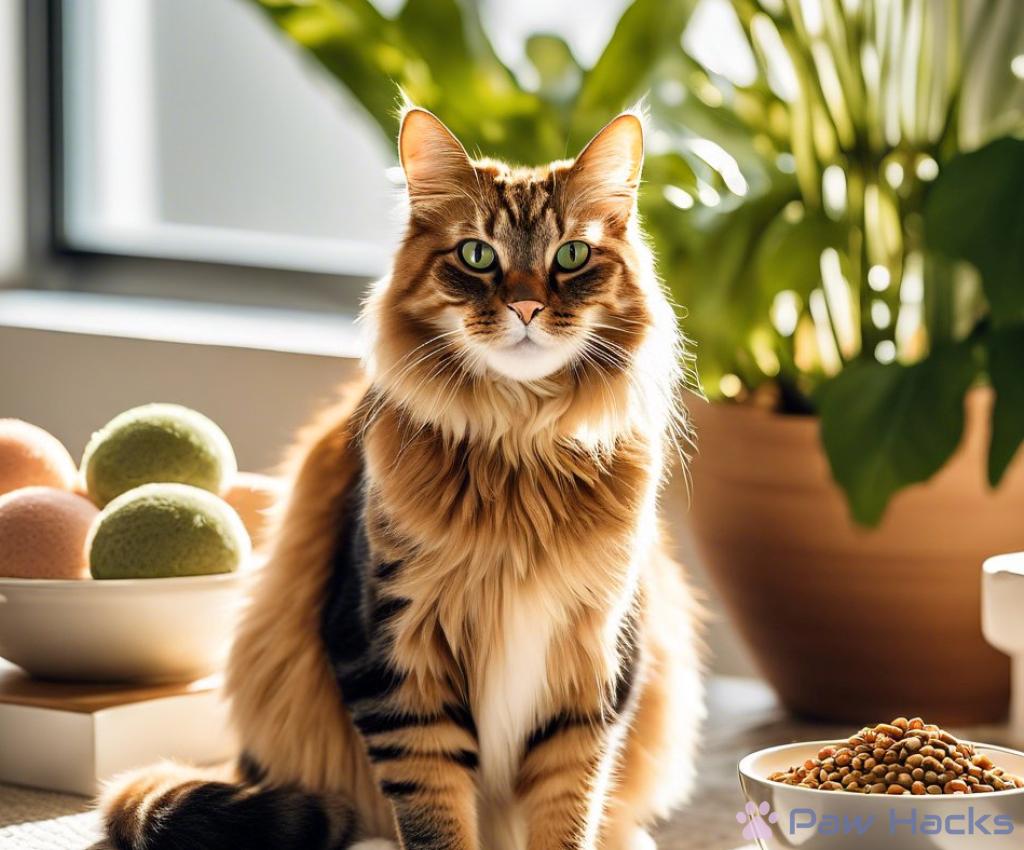Cat Haircoat Health Tips
The Essential Guide to a Shiny Cat Coat: Nutrition That Matters

A shiny and healthy cat coat is often a reflection of a cat’s overall well-being, and nutrition plays a crucial role in this aspect. Just like humans, cats require a balanced diet rich in essential nutrients to maintain their fur’s luster and vitality. But what exactly does a cat need to achieve that enviable shine? Let’s explore the key components of feline nutrition that can transform your cat’s coat.
To ensure your cat’s coat is as glossy as possible, it’s important to focus on specific nutrients. Here’s a list of the essential elements that contribute to a shiny fur:
- Omega-3 and Omega-6 Fatty Acids: These healthy fats are vital for skin health and coat shine. They help reduce shedding and promote a soft, shiny coat.
- High-Quality Protein: Cats are obligate carnivores, which means they thrive on protein-rich diets. Look for high-quality meat sources to support fur health.
- Vitamins A and E: These vitamins are crucial for skin health and can help prevent dryness and flakiness in your cat’s coat.
- Biotin: Often called the ‘hair and nails vitamin,’ biotin promotes healthier skin and a shinier coat.
Not all cat food is created equal. When selecting food for your feline friend, it’s important to read labels carefully. Look for foods that list real meat as the first ingredient and contain a balance of the nutrients mentioned above. Here’s a simple table to compare different types of cat food:
| Type of Cat Food | Protein Source | Omega Fatty Acids | Vitamins Included |
|---|---|---|---|
| Dry Kibble | Chicken, Fish | Often added | A, E |
| Canned Wet Food | Beef, Salmon | Higher content | A, E, Biotin |
| Raw Diet | Varied Meats | Natural sources | A, E, Biotin |
In conclusion, providing your cat with a diet rich in essential nutrients is key to achieving and maintaining a shiny coat. By focusing on quality ingredients and the right balance of nutrients, you can help your feline friend shine bright.
Grooming Secrets: Techniques for a Healthy and Beautiful Fur

When it comes to maintaining a stunning and healthy coat for your feline companion, grooming is just as crucial as nutrition. Regular grooming not only helps to keep your cat’s fur looking its best but also promotes skin health, reduces shedding, and strengthens the bond between you and your pet. Here are some grooming techniques that can elevate your cat’s fur game.
Brushing your cat regularly is one of the most effective ways to maintain their coat’s health. This simple act helps remove loose hair, dirt, and debris while distributing natural oils throughout the fur, resulting in a shiny finish. Depending on your cat’s coat type, the frequency and type of brush may vary.
- Short-haired Cats: Brush at least once a week using a soft bristle brush.
- Long-haired Cats: Daily brushing is recommended with a slicker brush to prevent matting.
Although cats are notorious for being self-groomers, occasional baths can be beneficial, especially if your cat has been outdoors or has skin issues. However, it’s essential to know when and how to bathe your cat properly. Use a gentle, cat-specific shampoo and ensure that the water temperature is lukewarm.
- Prepare the bathing area with all necessary supplies within reach.
- Wet your cat gradually, avoiding the head to minimize stress.
- Apply shampoo and lather gently, rinsing thoroughly to remove all residue.
- Wrap your cat in a towel post-bath to absorb excess water and keep them warm.
While grooming typically focuses on the fur, neglecting other grooming aspects can impact overall coat health. Regularly check your cat’s ears for dirt and wax buildup, cleaning them with a vet-recommended solution. Additionally, keeping your cat’s nails trimmed is crucial to prevent snagging and discomfort, which can lead to reduced grooming behavior.
By incorporating these grooming secrets into your routine, you can significantly enhance your cat’s coat health. Remember, a well-groomed cat not only looks beautiful but also feels great!
Understanding Shedding: How to Manage Your Cat’s Hair Loss
Every cat owner knows that shedding is a natural part of feline life. However, understanding the reasons behind your cat’s shedding can help you manage it effectively. While some shedding is normal, excessive hair loss can indicate underlying health issues or poor grooming habits. With the right approach, you can minimize shedding and keep your home and your cat looking their best.
Shedding can occur for various reasons, and recognizing these factors is crucial. Seasonal changes, stress, and health conditions can all play a role in how much your cat sheds. Here are some common culprits:
- Seasonal Changes: Cats often shed their winter coats in spring and grow thicker fur in fall. This natural process can lead to noticeable differences in hair around your home.
- Stress and Anxiety: Changes in environment or routine can lead to increased shedding. Cats may express their anxiety through excessive grooming.
- Health Issues: Conditions such as allergies, hormonal imbalances, or skin infections can cause more than usual shedding. If you notice bald patches or skin irritations, consulting a veterinarian is essential.
Managing your cat’s shedding involves a combination of proper grooming, nutrition, and environmental adjustments. Here are some practical tips to help you tackle this common challenge:
- Regular Grooming: Invest time in brushing your cat regularly. This not only helps remove loose hair but also distributes natural oils, promoting a healthier coat.
- Quality Diet: Feed your cat a balanced diet rich in essential nutrients. Foods containing Omega-3 and Omega-6 fatty acids can enhance coat health and reduce shedding.
- Reduce Stress: Create a calm environment for your cat. Provide safe spaces and engaging toys to alleviate anxiety and prevent excessive grooming.
- Regular Vet Check-ups: Schedule routine veterinary visits to ensure your cat’s overall health. Early detection of any health issues can help manage shedding effectively.
By understanding the reasons behind shedding and implementing these practical tips, you can greatly improve your cat’s haircoat health. A well-groomed cat not only looks good but also feels comfortable in their own skin, making for a happier feline friend.
Common Skin Issues in Cats: Prevention and Care Tips
Maintaining a healthy coat goes hand in hand with ensuring your cat’s skin is in top condition. Just like humans, cats can experience a variety of skin issues that may affect their overall well-being and the luster of their fur. Understanding the common skin problems that can arise is crucial for any cat owner. Not only can these issues be uncomfortable for your feline friend, but they can also lead to further complications if left untreated. Therefore, being proactive in prevention and care can significantly enhance your cat’s skin health.
There are several skin issues that cats may encounter, each with its own set of symptoms and underlying causes. One prevalent problem is allergies, which can stem from environmental factors like pollen, dust mites, or even certain foods. When cats react to allergens, they may develop itchy skin, leading to excessive scratching and potential hair loss. Another common issue is fleas and parasites, which not only irritate the skin but can also lead to more severe infections if not managed promptly. Additionally, fungal infections, such as ringworm, can cause patches of hair loss and flaky skin, requiring immediate attention.
To keep your cat’s skin healthy, prevention is paramount. Start by ensuring a balanced diet rich in essential nutrients. A diet that includes Omega-3 and Omega-6 fatty acids can significantly reduce the risk of skin issues by promoting a healthier coat and skin barrier. Regular grooming is also key; it helps remove dirt and allergens while allowing you to monitor your cat’s skin for any abnormalities. During grooming sessions, be vigilant for signs of irritation or unusual bumps, as early detection is crucial.
Moreover, maintaining a clean living environment is essential for skin health. Regularly wash your cat’s bedding and vacuum areas where they spend time to reduce allergens and parasites. For cats prone to allergies, consider consulting your veterinarian about hypoallergenic products or specific diets that may alleviate symptoms. It is also beneficial to keep your cat’s vaccinations up to date, as some skin conditions can be linked to viral infections.
If you notice any signs of skin irritation, such as excessive scratching, redness, or hair loss, don’t delay in seeking veterinary care. Early intervention can prevent minor issues from escalating into more serious conditions. Your veterinarian can offer tailored advice and treatment options, ensuring your cat remains comfortable and healthy.
The Role of Hydration: Keeping Your Cat’s Coat Lush and Vibrant
When it comes to maintaining a beautiful and healthy coat for your feline friend, hydration is often an overlooked yet crucial factor. Just as water is vital for overall health in humans, it plays an equally important role in your cat’s coat vitality. Sufficient hydration can lead to a softer, shinier, and more resilient fur, while dehydration can result in dryness, flakiness, and a dull appearance.
Water is essential for various bodily functions, including aiding in the absorption of nutrients that contribute to coat health. When your cat is well-hydrated, their skin remains supple and elastic, allowing for better oil distribution throughout the coat. This natural oil helps to keep the fur moisturized and shiny. On the contrary, insufficient water intake can lead to several issues:
- Dull Coat: A lack of moisture can cause the coat to lose its natural shine.
- Dry Skin: Dehydration often leads to flaky skin, which may result in itching and discomfort.
- Increased Shedding: Poor hydration can exacerbate shedding, leading to more hair around your home.
Keeping your cat hydrated is straightforward with a few simple strategies. Here are some effective ways to encourage your cat to drink more water:
- Fresh Water Daily: Ensure your cat has access to clean, fresh water every day. Change the water regularly to encourage drinking.
- Multiple Water Bowls: Place several water bowls around your home to make it convenient for your cat to drink.
- Water Fountains: Consider investing in a cat water fountain. Many cats prefer running water, which can entice them to drink more.
- Moisture-Rich Foods: Incorporate wet cat food into your pet’s diet. This not only provides additional hydration but is also beneficial for overall health.
By prioritizing hydration, you can help your cat maintain a lush and vibrant coat. Remember, a well-hydrated cat is not just visually appealing, but also feels comfortable and healthy in their own skin.
Share this content:



